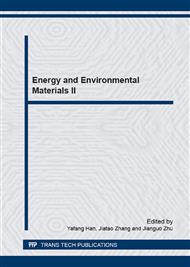p.411
p.418
p.425
p.430
p.435
p.441
p.447
p.458
p.464
Life Cycle Assessment of Cement Clinker Production Using Coal Gangue as Alternative Raw Material and Fuel
Abstract:
Life cycle assessment (LCA) was carried out to quantify and analyze the environmental impact and benefit caused by the utilization of coal gangue as alternative raw material and fuel in cement clinker production. The optimal dosage of coal gangue was determined by comparing among different mixing amount scenarios and Portland cement clinker (clinker without adding any waste) considering the phases of coal gangue disposal, transportation, and raw meal grinding and clinker calcination. The results showed that: 1) After adding coal gangue to the raw meal, almost all the considered environmental impacts of cement clinker including human toxicity potential, photochemical smog potential, especially abiotic depletion potential decreased significantly. However, global warming potential and acidification potential increased slightly in comparison with Portland cement clinker. 2) Compared with the Portland cement clinker, the single environmental indicator reduced after adding coal gangue and the indicator decreased gradually with the dosage increasing.
Info:
Periodical:
Pages:
435-440
Citation:
Online since:
March 2015
Authors:
Keywords:
Price:
Сopyright:
© 2015 Trans Tech Publications Ltd. All Rights Reserved
Share:
Citation:


